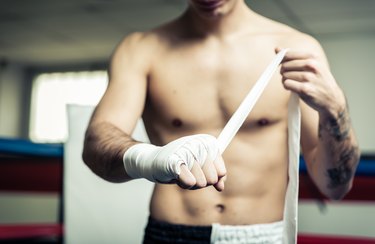
So you watched the movie "Snatch" and now you want to be a bare knuckle boxer like Brad Pitt. But how do you get started? First and foremost, you need to know that bare knuckle boxing is unlicensed in many states/countries and often illegal. However, on the British Isles, it's still very popular and has even made a comeback in the U.S.
Since modern-day boxing originates from bare-knuckle boxing, the usual training regiment is very similar to that of a "regular" boxer, with a few a differences. To find out more about that, refer to this Step-by-Step Boxing Training Program.
Video of the Day
Video of the Day
Strengthen Your Hands
"Boxing fractures" are very common, both in boxing and in MMA. Wrapping the hands the way many do in boxing actually seems to make the bones in the hands weaker and more brittle. So you may want to only wrap them for fights or when you have hard sparring.
Start hitting both focus mitts and heavy bags with just MMA gloves, to condition both your knuckles and wrists. It also helps with the precision in the strikes, to make sure that you land the punches with the first two knuckles, since boxing gloves are more forgiving.
Do at least one round of your bag work with no gloves or hand wraps. As your hands and wrists grow accustomed to this new stress, do increasingly more of your bag work barehanded until you're working all of your rounds without protection. Canvas bags are slightly better than vinyl bags for this, as they're rougher and will build your callouses faster.
Wear Gloves Strategically
A second difference between regular boxing and bare knuckle boxing is more subtle but even more important: defense. Because the are no gloves, you can't block punches the way you do in regular boxing, since there's no foam on your, nor your opponent's hands. It also makes the fist being thrown at your face or body is a lot smaller and can easier slip through your guard.
Because it's not possible to spar without gloves, due to the risk of cuts (since it's bone on bone, fighters cut a lot easier in bare knuckle fighting and thus, there's often more blood), it's a little bit of a catch 22.
You can wear regular boxing gloves for hard sparring days (you need those as well) and MMA gloves for lighter sparring days, to give a more realistic feel, for both defense, as well as how to slip your own punches in on your opponent.
Take Care of Your Hands
Apply antibiotic ointment immediately to any scrapes or abrasions you find on your hands after a workout. This will speed the healing and avoid infections, which are a common result of scraping up your hands on a punching bag.
Ice your knuckles and wrists for 20 to 30 minutes after each workout, to ease discomfort and speed up how quickly you can get back to training. Put bandages on any areas of your hands that need it, but only after you're done icing. Otherwise, the bandages will just fall off during icing.
Good luck, be safe and train hard!